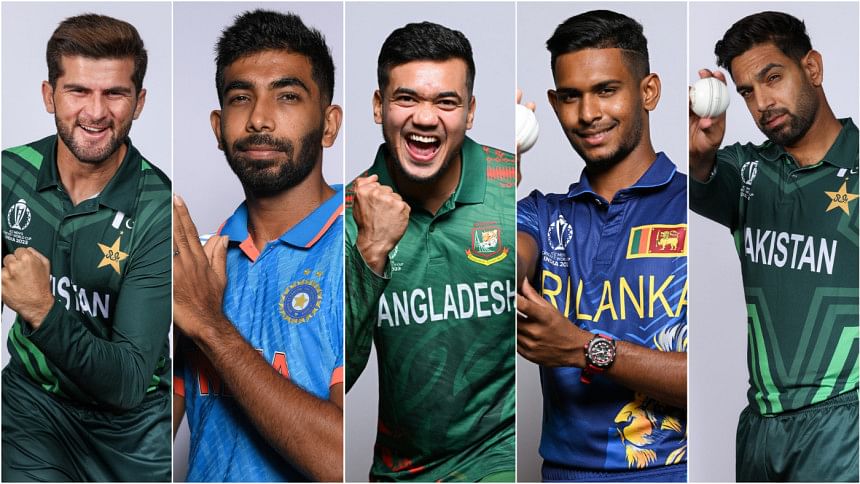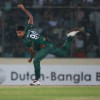The rise of the South Asian pace attack

When last the ODI World Cup was played in South Asia, in 2011, five of the top seven wicket-takers in that tournament were spin bowlers. In the recent Asia Cup, however, in which more matches were played in Colombo (a notoriously spin-friendly venue) than any other venue, five of the top seven wicket-takers were seam bowlers.
While Pakistan have often had world class quicks, and Sri Lanka occasionally had gifted fast bowlers too, South Asia has in the last decade begun to produce seam-bowling talent on a greater scale, where once the region was better known for its slow bowlers. Among the top seven in the Asia Cup was Bangladesh's Taskin Ahmed, who took nine wickets at 19.11 across the tournament. Also among those who turned heads was Tanzim Hasan, whose 2 for 32 was vital to Bangladesh's consolation win over India. Mustafizur Rahman's skillset is well known, but his 3 for 50 in that game (followed up by a 3 for 27 against New Zealand, less than a week later), wasn't too shabby either.
But fast bowling may be entering something of a golden age beyond Bangladesh. India have Jasprit Bumrah, of course, perhaps the most dangerous of South Asia's bowlers at the death, and one of the most enjoyable to watch. Mohammad Siraj proved during the Asia Cup that he would not be left in Bumrah's shadow, when he bowled a searing opening spell that reaped a match-defining 6 for 21. India also have the bustling intensity of Mohammad Shami in their squad.
Pakistan, of course, have the masterful Shaheen Afridi, as well as Haris Rauf, who has a chance of being the quickest bowler on show at the World Cup, even if he is occasionally expensive in this format. And Sri Lanka have a variety of express quicks capable of breaching 140kph -- Dushmantha Chameera, who has been their best fast bowler in the past three years, but has been largely out with injury in 2022, Dilshan Madushanka, the left-armer who bowls killer inswingers with the new ball, and the round-arm express Matheesha Pathirana, who bowls exceptionally well towards the end of an innings, but is far less reliable at the start.
So between all these bowlers, does South Asia now have the fast-bowling stocks to challenge the SENA (South Africa, England, New Zealand, Australia) teams' own pace stocks? It's hard to see why not, particularly as South Asian seamers will be more accustomed to the kinds of tracks expected in India.
Cutters, among the first skills that seamers learn in this part of the world, may play a significant role in the World Cup. With the squares in India likely to become drier and more abrasive as the tournament goes on, bowlers who can disguise their slower balls, and in particular can bowl slower deliveries that turn off the surface, may become more effective.
Every bowler listed in this article so far has the ability to deliver a good cutter. When it comes to Mustafizur, the cutters are almost his stock ball. But there are other skills these bowlers have developed to be effective on South Asian decks too -- many can bowl the slower bouncer that stops on the pitch, and surprises batters late in the innings. Most have now developed the wobble-seam delivery, which brings about a lot of middle-overs wickets in the white-ball formats.
And even if the spinners are proving ineffective during the 15-40 overs stage, South Asian quicks such as Rauf, Bumrah, and Pathirana have become adept at making breakthroughs through that period, primarily because of the pace with which they bowl. These are bowlers whose yorkers, and even low full tosses, are so deadly, that they take pitches out of the equation completely.
Quicks from other teams have learned to bowl in South Asian conditions too, of course. Thanks to tournaments like the IPL, PSL, BPL and LPL, many of the bowlers from the non-Asian nations have substantial experience in Asian conditions.
But while in previous World Cups, Asian nations would pin the majority of their bowling hopes on spin bowlers, even going so far as to pack their side with spin-bowling all-rounders (as Sri Lanka did in 1996, and which India did to a lesser degree in 2011, when Yuvraj Singh claimed 15 wickets), they now have seam bowlers who are as penetrative, and in some cases more effective, in these conditions, than their slow bowlers.
If the World Cup in England in 2019 was a showcase of great yorker bowling -- Mitchell Starc, Lockie Ferguson, Jofra Archer, and Bumrah all dusting off their most vicious toe-crushers right through the tournament, perhaps the 2023 World Cup is poised to be a tournament that sees a greater variety of the fast-bowlers' arsenal on display.
In no World Cup before, however, have South Asia's own quicks been more poised to be on the cutting edge of the world's great attacks.

 For all latest news, follow The Daily Star's Google News channel.
For all latest news, follow The Daily Star's Google News channel. 









Comments